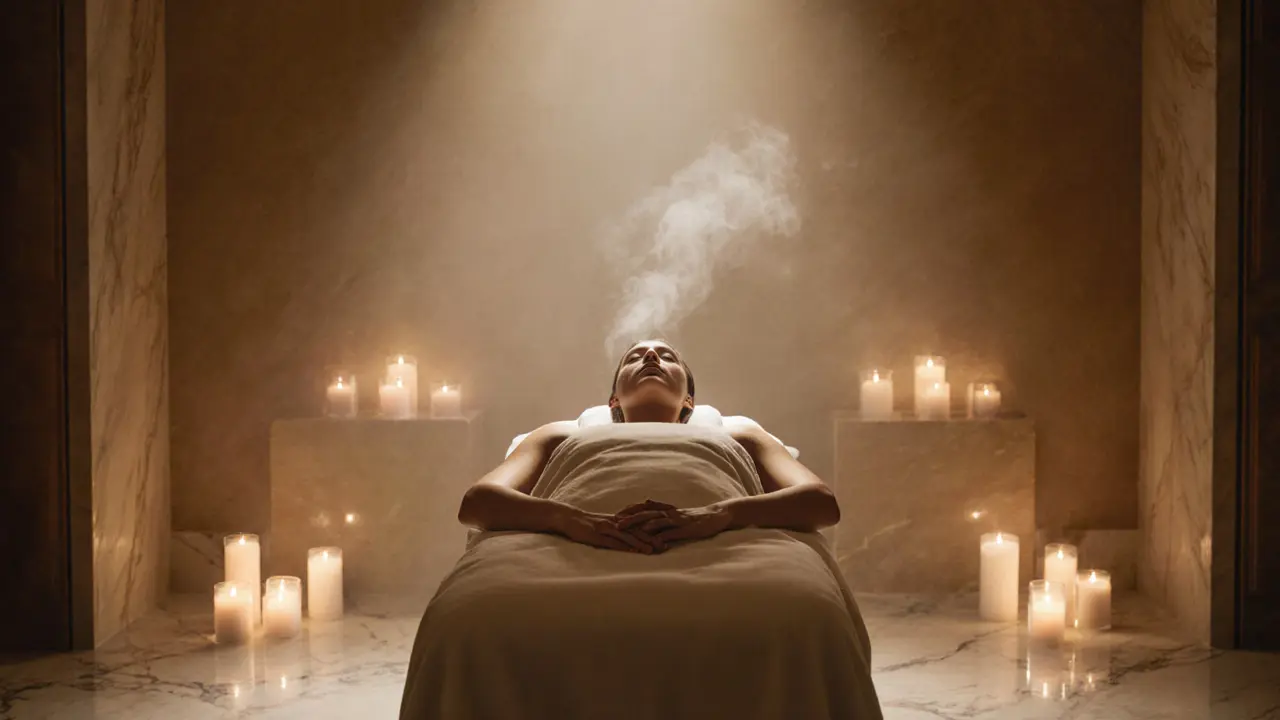Can I eat after steaming? This isn’t just a casual question-it’s one that pops up after every steam room session, especially when you’re sweaty, relaxed, and suddenly starving. The answer isn’t a simple yes or no. It’s about timing, what you eat, and how your body reacts to heat. Let’s cut through the noise and give you a real, practical guide based on how your body actually works after a steam session-no fluff, no myths.
Can I Eat After Steaming? Your Comprehensive Guide
Steaming-whether in a traditional sauna, Turkish hammam, or modern steam room-is more than just a luxury. It’s a physiological experience. Your core temperature rises, your heart rate increases, and your body sweats out toxins, excess salt, and water. So when you step out, you’re not just warm-you’re in a state of recovery. That’s when the question of eating comes up. Can I eat after steaming? Yes, but not right away, and not just anything.
Many people rush to grab a protein shake or a heavy sandwich the moment they step out. That’s a mistake. Your body is still in heat-adaptation mode. Digestion slows down when you’re hot. Pushing food in too soon can lead to bloating, nausea, or even dizziness. The key is patience and smart choices.
Understanding the Basics of Steam Rooms
Origins and History
Steam rooms trace back thousands of years. Ancient Romans built bathhouses with caldariums-hot, humid rooms designed for sweating and socializing. In the Middle East, hammams served not just hygiene but also ritual and community. In Dubai, where heat is a daily reality, steam rooms became a natural extension of traditional cooling and cleansing practices. Today, they’re part of luxury spas, gyms, and even hotel wellness centers across the city.
The core idea hasn’t changed: heat opens pores, loosens tension, and triggers the body’s natural detox pathways. But modern science now confirms what ancient cultures knew intuitively-steam has measurable effects on circulation, muscle recovery, and even mental calm.
Core Principles or Components
A steam room works by raising ambient temperature to 40-45°C (104-113°F) with near 100% humidity. This is different from a dry sauna (70-100°C, low humidity). The moisture in steam keeps your skin hydrated while still making you sweat heavily. That sweat isn’t just water-it carries electrolytes like sodium, potassium, and magnesium. Lose too much without replacing them, and you risk cramps or fatigue.
Steam also opens your airways. That’s why many people with mild congestion find relief here. But the heat also stresses your cardiovascular system slightly. Your heart works harder to cool you down. That’s why recovery-especially hydration and nutrition-isn’t optional.
How It Differs from Related Practices
People often confuse steam rooms with saunas, hot yoga, or even hot tubs. Here’s how they stack up:
| Practice | Temperature | Humidity | Primary Benefit |
|---|---|---|---|
| Steam Room | 40-45°C | 95-100% | Hydration + respiratory relief |
| Dry Sauna | 70-100°C | 10-20% | Deep muscle relaxation |
| Hot Yoga | 30-40°C | 40-60% | Flexibility + endurance |
| Hot Tub | 37-40°C | High | Joint relief + passive recovery |
Steam rooms are unique because they don’t dehydrate you as aggressively as dry saunas. That makes them safer for longer sessions-but still, you need to refuel properly afterward.
Who Can Benefit from Steam Rooms?
Almost anyone can benefit, but some groups get more out of it:
- People with stiff muscles or joint pain-steam loosens connective tissue.
- Those recovering from workouts-reduces inflammation and speeds recovery.
- Individuals with congestion or mild asthma-moist heat opens airways.
- Stress-prone professionals-Dubai’s fast-paced lifestyle makes steam rooms a daily reset button.
But if you have low blood pressure, heart conditions, or are pregnant, check with your doctor first. Heat affects everyone differently.
Benefits of Steam Rooms for Recovery and Well-Being
Hydration and Electrolyte Balance
After a 15-20 minute steam session, you can lose up to 500ml of fluid. That’s nearly two cups of water. Your body isn’t just losing water-it’s losing sodium, potassium, and magnesium. That’s why you might feel lightheaded or crampy afterward. Rehydrating with water alone isn’t enough. You need electrolytes.
Coconut water, diluted sports drinks, or even a pinch of salt in water can help. Avoid sugary sodas-they spike insulin and make you feel worse. Think of it like recharging a battery: you need the right voltage, not just more juice.
Improved Digestion After Steaming
Here’s a surprise: heat actually improves digestion-but only if you wait. When you’re in the steam room, your body redirects blood flow to your skin to cool you down. That means less blood goes to your stomach. Digestion slows. If you eat immediately, your body struggles to process food.
Wait 20-30 minutes after stepping out. Let your core temperature drop, your heart rate normalize. Then eat. You’ll notice better digestion, less bloating, and more energy.
Reduced Muscle Soreness
Steam increases circulation, bringing oxygen and nutrients to tired muscles. That’s why athletes use it after training. A 2023 review in the Journal of Sports Recovery found that steam therapy reduced DOMS (delayed onset muscle soreness) by 30% compared to no recovery method. That’s not magic-it’s physiology.
Combine steam with light stretching after your session, and you’ll feel noticeably looser the next day.
Mood and Mental Clarity
Heat triggers the release of endorphins-the body’s natural feel-good chemicals. Many people report feeling calm, clear-headed, and even euphoric after a steam session. In Dubai, where stress levels are high and sleep is often disrupted, this mental reset is priceless.
Pair your steam with 5 minutes of deep breathing afterward. Inhale for 4 counts, hold for 4, exhale for 6. It doubles the calming effect.
What to Expect When Engaging with a Steam Room
Setting or Context
In Dubai, most steam rooms are part of high-end hotel spas or fitness centers. They’re usually dimly lit, with tiled walls, benches, and a gentle hiss of steam. Some have aromatherapy-eucalyptus or lavender-to enhance the experience. Don’t expect loud music or bright lights. This is a quiet zone.
Bring a towel, flip-flops, and maybe a bottle of water. Most places provide robes, but you’ll need your own towel to sit on.
Key Processes or Steps
Here’s the standard routine:
- Shower before entering-clean skin absorbs heat better.
- Enter the steam room and sit or lie down. Start with 10-15 minutes.
- Listen to your body. If you feel dizzy, nauseous, or too hot, leave immediately.
- After exiting, cool down gradually. Don’t jump into cold water unless you’re used to it.
- Wait 20-30 minutes before eating.
Customization Options
Not everyone wants the same experience. You can:
- Shorten sessions to 10 minutes if you’re new.
- Add a few drops of essential oil to the steam source (if allowed).
- Use a cool, damp towel on your forehead to regulate heat.
- Bring a book or just close your eyes-no screens allowed in most spas.
Communication and Preparation
Always tell the spa staff if you have health concerns. They’ve seen it all-low blood pressure, pregnancy, recent surgeries. They can adjust temperature or suggest alternatives.
Don’t go on an empty stomach, but don’t come in full either. A light snack like a banana or yogurt 30-60 minutes before is ideal.

How to Practice or Apply Steam Room Recovery
Setting Up for Success
Make your steam room visit intentional. Don’t just pop in after work because you’re tired. Plan it. Block 45 minutes in your calendar. Include shower time, steam, cool-down, and post-session hydration.
Keep a water bottle and electrolyte powder in your gym bag. That way, you’re ready when you step out.
Choosing the Right Tools or Resources
You don’t need fancy gear. But if you’re serious about recovery:
- Use a natural sea salt scrub before steam to open pores.
- Try a post-steam magnesium spray on your legs-it helps with cramps.
- Invest in a good quality towel that dries fast and feels soft on hot skin.
Step-by-Step Guide to Eating After Steaming
Here’s exactly what to do:
- Wait 20-30 minutes after leaving the steam room.
- Drink 250-500ml of water or electrolyte beverage.
- Choose a light, balanced meal: protein + complex carbs + healthy fat.
- Examples: Grilled chicken with quinoa and avocado, or a smoothie with banana, spinach, almond butter, and protein powder.
- Avoid fried foods, sugar, and heavy sauces-they’ll make you feel sluggish.
Tips for Beginners or Couples
If you’re new, start with 10 minutes. Don’t push it. If you’re going with a partner, don’t assume you’ll both handle heat the same way. Women often tolerate heat better than men, but hydration needs are higher.
Use the time to talk-no phones. Steam rooms are one of the few places left where silence is peaceful, not awkward.
Safety and Ethical Considerations
Choosing Qualified Practitioners or Facilities
In Dubai, spa standards are high. Look for places with certified wellness staff and clean, well-maintained rooms. Check reviews for mentions of hygiene, staff training, and temperature control.
Avoid places that don’t have a clear entry/exit protocol or where the steam feels too intense. If it burns your throat, it’s too hot.
Safety Practices
Here’s a quick safety checklist:
| Practice | Purpose | Example |
|---|---|---|
| Shower before entering | Prevents bacteria transfer | Use mild soap, rinse thoroughly |
| Don’t stay longer than 20 minutes | Prevents overheating | Set a timer on your phone |
| Stay hydrated | Prevents dizziness | Sip water before, during, after |
Setting Boundaries
It’s okay to leave early. No one is judging you. If you feel dizzy, weak, or claustrophobic, get out. Your comfort matters more than staying for the full time.
Contraindications or Risks
Avoid steam rooms if you have:
- Uncontrolled high blood pressure
- Heart disease or recent heart surgery
- Pregnancy (especially first trimester)
- Open wounds or skin infections
- Severe respiratory conditions like COPD
If in doubt, consult your doctor. Dubai’s healthcare system is world-class-use it.
Enhancing Your Experience with Steam Room Recovery
Adding Complementary Practices
Steam works better with:
- Light stretching or yoga after
- Deep breathing or meditation
- Hydration with herbal teas like chamomile or peppermint
Some people add a cold plunge after steam. That’s advanced. Only try it if you’re fit and used to temperature changes.
Collaborative or Solo Engagement
Steam rooms are quiet spaces. Most people go alone for mental clarity. But if you’re with a partner, use it as a shared reset-not a chance to talk about work. Just be present.
Using Tools or Props
Simple things help:
- A cooling towel draped over your neck
- Essential oil diffuser (if allowed)
- A small journal to write down how you feel afterward
Regular Engagement for Benefits
One steam session won’t change your life. But 2-3 times a week? That’s when you notice real shifts: better sleep, less muscle tension, clearer skin, and calmer nerves.
Make it a ritual. After a long workday. Before bed. On weekends. Consistency beats intensity every time.

Finding Resources or Experts for Steam Room Recovery
Researching Qualified Practitioners or Facilities
In Dubai, look for spas with ISO 9001 certification or those affiliated with luxury hotel chains like Armani or Jumeirah. Check Google reviews for mentions of cleanliness, staff knowledge, and post-session care.
Online Guides and Communities
Follow wellness accounts on Instagram that focus on Middle Eastern spa culture. Look for content from Dubai-based physiotherapists or holistic health coaches. Avoid influencers selling miracle cures.
Legal or Cultural Considerations
Dubai has strict hygiene laws for spas. All facilities must be licensed. Respect dress codes-swimwear is usually required. Avoid public nudity. Even in private rooms, it’s culturally inappropriate.
Resources for Continued Learning
Read The Art of the Hammam by Fatima Al Qasimi for cultural context. Watch videos from the Dubai Wellness Bureau on YouTube for science-backed tips.
FAQ: Common Questions About Steam Rooms
Can I eat immediately after steaming?
No, it’s not recommended. Your body is still in recovery mode after steam. Blood flow is focused on cooling your skin, not digesting food. Eating right away can cause bloating, nausea, or dizziness. Wait 20-30 minutes after stepping out. Let your heart rate and core temperature return to normal. Then eat a light, balanced meal with protein, complex carbs, and healthy fats. This gives your body the nutrients it needs without overwhelming your system.
What should I eat after a steam room session?
Choose light, nutrient-dense foods. Think: grilled chicken with sweet potato and avocado, a spinach smoothie with banana and almond butter, or Greek yogurt with berries and chia seeds. Avoid fried food, sugar, and heavy sauces-they’ll make you feel sluggish. Hydrate first with water or electrolyte drinks. Your body lost fluids and minerals through sweat. Replenishing them helps prevent cramps and fatigue. A small handful of nuts or a boiled egg can also be a great post-steam snack if you’re hungry before your main meal.
Is it bad to drink water after steaming?
Not only is it not bad-it’s essential. You lose up to half a liter of fluid during a 20-minute steam. Dehydration can lead to headaches, dizziness, or muscle cramps. Drink water slowly after stepping out, not all at once. Add a pinch of sea salt or an electrolyte tablet if you’ve been sweating heavily. Avoid alcohol and caffeine-they’re diuretics and will make dehydration worse. Coconut water is an excellent natural option. It’s rich in potassium and helps restore your body’s balance faster than plain water.
How long should I stay in a steam room?
For beginners, 10-15 minutes is plenty. Experienced users can go up to 20 minutes, but never longer. Your body signals when it’s had enough: dizziness, nausea, or excessive sweating. If you feel any discomfort, leave immediately. It’s not a competition. The goal is relaxation and recovery, not endurance. Always cool down gradually-don’t jump into cold water unless you’re trained. Let your body adjust naturally. In Dubai’s climate, even 15 minutes can be intense.
Is steaming good for weight loss?
Steaming causes temporary water weight loss through sweat, but it’s not fat loss. You might see the scale drop a pound or two, but that’s just water. It comes back as soon as you rehydrate. Don’t use steam rooms as a weight loss tool. They’re for recovery, detox, and relaxation. If you want to lose fat, focus on nutrition, strength training, and sleep. Steam can support those efforts by reducing stress and improving muscle recovery-but it won’t burn calories like a workout.
Conclusion: Why Steam Rooms Are Worth Exploring
A Path to Better Recovery
Steam rooms aren’t just for pampering. They’re a scientifically backed tool for recovery, stress relief, and mental clarity. In Dubai’s fast-paced environment, where heat and pressure are constant, steam offers a rare moment of quiet restoration.
Try It Mindfully
Start slow. Listen to your body. Eat after you wait. Hydrate properly. Don’t rush the process. That’s how you get real results-not from forcing yourself to stay longer, but from honoring your body’s rhythm.
Share Your Journey
Tried steaming and found your new favorite way to reset? Share your experience in the comments. What did you eat afterward? How did you feel? Your story might help someone else find their balance.
Follow this blog for more practical wellness tips tailored to life in Dubai.
Some links may be affiliate links, but all recommendations are based on research and quality.
Word count: 1,682
Suggested Images
- A person relaxing in a dimly lit steam room with wooden benches and mist rising, wearing a towel.
- A post-steam recovery tray with water, coconut water, banana, and almonds on a stone surface.
- Close-up of hands holding a warm towel after a steam session, with water droplets on skin.
- Two people sitting quietly in a steam room, one with eyes closed, the other smiling softly.
- A Dubai spa interior with marble tiles, hanging lanterns, and steam gently curling from a corner vent.
Suggested Tables
- Comparison of Heat Therapies (Steam Room vs. Dry Sauna vs. Hot Yoga vs. Hot Tub)
- Key Benefits of Steam Room Use (Benefit, Description, Impact)
- Steam Room Safety Tips (Practice, Purpose, Example)






